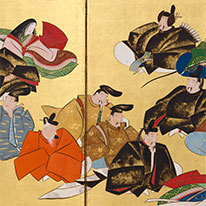General Information
| Exhibition Title | Special Exhibition The Thirty-Six Immortal Poets: Elegant Arts of the Classical Japanese Court |
|---|---|
| Period | October 12-November 24, 2019 The exhibition has two installations: Part I: October 12-November 4, 2019 Part II: November 6-November24, 2019 Works on view are subject to change without notice. |
| Venue | Kyoto National Museum, Heisei Chishinkan Wing |
| Transportation | JR, Kintetsu Railway, Keihan Railway, Hankyu Railway, City Bus |
| Closed | Mondays *The museum will be opened on Monday November 18, 2019. *The museum will be opened on Monday October 14 and Monday November 4 (national holidays) and closed on Tuesday October 15 and, Tuesday November 5, 2019. |
Special Exhibition Hours | 9:30 a.m.-6:00 p.m. (Entrance until 5:30 p.m.) Fridays, Saturdays 9:30 a.m.-8:00 p.m. (Entrance until 7:30 p.m.) |
| Special Exhibition Admission | Adult 1,600 yen (1,400 yen) Univ. Student 1,200 yen (1,000 yen) High School Student 700 yen (500 yen)
|
| Audio Guide | Fee 550yen(includes tax) Time 35 min Language Japanese, English, Chinese, Korean 9:30 a.m.-5:15 p.m.(Fridays, Saturdays 9:30 a.m.-7:15 p.m.) |
| Organized by | Kyoto National Museum, Nikkei Inc., NHK Kyoto, NHK PlanNet Kinki, The Kyoto Shimbun Co., Ltd. |
| In conjunction with | Kyoto Prefectural Board of Education, Kyoto City Board of Education, Kyoto City Tourism Association |
| With the support of | Iwatani Corporation, Shoyeido Incense Co., Sompo Japan Nipponkoa Insurance Inc., Daikin Industries, Ltd., Takenaka Corporation, Nissha Co., Ltd., Mitsui & Co., Ltd., Mitsui Fudosan Co., Ltd. |
| With the cooperation of | Daiko Electric CO.,LTD. |
Images from the Exhibit
Exactly one hundred years ago, in 1919, Japan's newspapers were abuzz with extraordinary news. A group of industrialist connoisseurs had acquired one of the country's most precious art treasures: a set of thirteenth-century handscrolls known as the Satake Version, Thirty-Six Immortal Poets. Even more surprising was the fact that these wealthy financiers were going to separate the handscrolls into individual fragments to be divided amongst themselves and remounted as hanging scrolls for private use in their own tearooms.
Thereafter, to possess one of these Satake fragments came to be seen as the ultimate Japanese status symbol, defining its owner as an undisputed member of the country's cultural elite. Over the course of the twentieth and early twenty-first centuries, the paintings moved from private collection to private collection, their whereabouts often unknown even to specialists.
This exhibition re-unites these paintings in the most comprehensive assemblage ever held since their dispersal a century ago. In addition to the legendary fragments themselves, the show features an array of exquisite artworks related to the Thirty-Six Immortal Poets and the elegant literary court culture from which they developed.
Section I
Anthology of Poems by the Thirty-Six Immortal Poets: A National Treasure and its Famous Calligraphers
The exhibition begins with the Heian period (794–1185), the era at the root of classical Japanese
beauty, and its famous calligraphers. Japanese waka poetry colored the private and public life of
the Heian period court. Its practice immortalized verse with flowing hiragana script on beautiful
bits of rare, luxurious paper. One of the most definitive works of poetry and calligraphy was the
Anthology of Poems by the Thirty-Six Immortal Poets, a collection of exemplary works by thirty-six
poets from the Heian period (794-1185), now a designated National Treasure.
The Thirty-Six Immortal Poets refer to a group of thirty-six Japanese poets from the seventh to the
tenth centuries. They were chosen by the scholar-poet Fujiwara no Kinto (966-1041) as the greatest
poets and included into his poetry anthology, the Selection of Thirty-Six Poets (ca. 1009
-12). Later, the thirty-six poets became frequently visualized in the arts. The world of
Japanese poetry would feel the effects of Kinto's selection, known as
the height of the aesthetic of ink, paper, and poem, for millennia to come.
Section II
Kakinomoto no Hitomaro, Saint of Poetry
Kakinomoto no Hitomaro (dates unknown) is one of the saints of Japanese poetry: an influential
poet, he became a subject of worship after his death. His verses featured prominently in the Nara
period (710-794) Man'yoshii ("Collection of Ten Thousand Leaves"), the earliest poetry anthology.
Unsurprisingly, Fujiwara no Kinto (966-1041) included him in his selection of thirty-six poets,
which only increased Hitomaro's fame.
Both the spirit and the image of Hitomaro wove their way throughout late Heian culture. For
example, some aristocrats would convene poetry gatherings that were known as "Hitomaro Portrait
Offerings" and hang up a portrait of the poet. They would compose waka verses and offer these
before the portrait in hopes receiving divine poetic intervention. This inclusion of the painted
image in poetry gatherings was just one of the many ways Hitomaro and his image became a cultural
fixture.
The traditions which invoked the image of Hitomaro seem to have been important in the evolution of
the Thirty-Six Immortal Poets paintings: they provided a baseline for the creation and use of
images of poets who lived centuries in the past. This section of the exhibition introduces the
visual culture of Hitomaro portraits: not just the poet himself, but also writing boxes which were
closely linked to the practice of waka writing, and along with
brush and paper, were regarded as a symbol of the cultured gentleman.
Section III
The Greatest Immortal Poets of All: The Satake Version Thirty-Six Immortal Poets
Artists produced many versions of the Thirty-Six Immortal Poets during Japan's middle ages and premodern period. The most famous copy, however, is the so-called Satake version. Its best-known owner was the Satake family, feudal lords of the Akita domain in northern Japan. The Satake version originally comprised two illustrated handscrolls. However, private collectors worked together to purchase the scrolls and split them up in 1919. The two scrolls turned into a series of thirty-seven fragments, each featuring the painting of a poet and his exemplary composition. The painting's division shocked the world and made national headlines—never had an artwork been known to meet such a cruel fate.
Section IV
Myriad Paintings of Many Immortals
Many paintings of the Thirty-Six Immortal Poets exist, each with its own distinct set of characteristics. They range from black and white to full vibrant color, from cute and lovely to striking and sober. Like the Satake version of the Immortals, some of these paintings began as sets of handscrolls, and like the Satake version they were divided into a series of individual portraits for viewers to contemplate in different formats. Unlike the Satake version, however, we have little to no idea when each copy was divided. This section introduces exemplary works from the Kamakura (1185–1333) and Nanbokucho (1333–1392) periods, tracing the evolution of the Immortals' conception and representation through the centuries.
Section V
Waka Poetry and Art in the Kamakura period
The Kamakura period (1185–1333) gave rise to Japan's first era of military rule. The emperor lost political sway to the shogun but retained his cultural influence. This period gave rise to nine poetry collections commissioned by the imperial court, including the Shin kokin wakashu ("New Collection of Poems from Ancient and Modern Times"), Shoku goshui wakashu ("Later Collection of Poems, Continued"), and more. The court maintained cultural hegemony in other pursuits as well, like calligraphy, decorative papermaking and narrative painting. The themes of this calligraphy and painting may have changed with the mood of the times, but their production never ceased.
Section VI
The Immortal Poets in the Edo Period
The Immortal Poets were a cultural product of early and medieval Japan, but their presence
persisted far into the premodern period. As an epilogue to this exhibition, we have brought
together Edo period (1615-1868) masterworks which take up the topic of the Immortals.
The religious significance of the Immortals grew leading up to the Edo period, and they appeared
with increasing frequency on votive plaques offered at shrines. Some of the most famous artists in
the history of Japan painted these plaques, many of which survive today. Once the Edo period began,
however, the visual culture of the Immortals transformed. The main painting schools of the period,
including the Tosa, Kano, and Rinpa, each offered up new and different takes, imbuing the theme with vitality all the way up to the modern period.











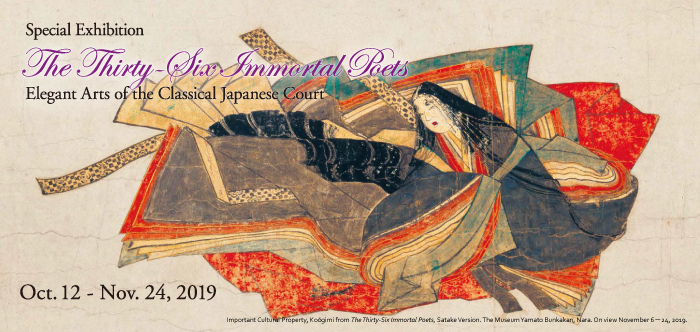
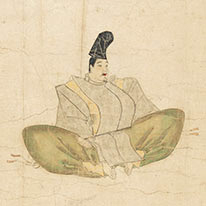
![Important Cultural Property; Koōgimi from the Thirty-Six Immortal Poets, Satake Version; The Museum Yamato Bunkakan, Nara [on view: November6–24, 2019]](../../../jp/special/img/20191012/satake_2019_02_tmb.jpg)
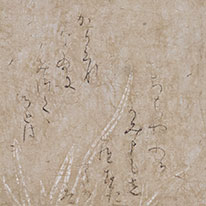
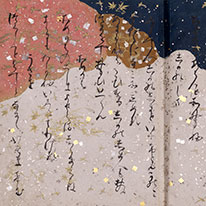
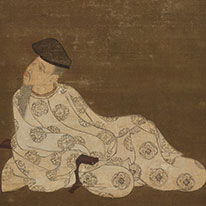
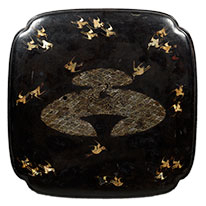
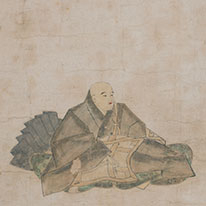
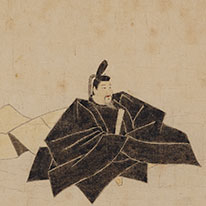
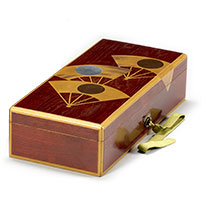
![Important Cultural Property; Nakatsukasa from The Thirty-Six Immortal Poets, Go-Toba-in Version; Senju-ji Temple, Mie [on view: October29–November24, 2019]](../../../jp/special/img/20191012/kasen_4-1_1F-2_20191012_tmb.jpg)
![Important Cultural Property; Lady Ise from The Thirty-Six Immortal Poets, Go-Toba-in Version; Senju-ji Temple, Mie [on view: October29–November24, 2019]](../../../jp/special/img/20191012/kasen_4-2_1F-2_20191012_tmb.jpg)
![Important Cultural Property; Koōgimi from The Thirty-Six Immortal Poets, Go-Toba-in Version; Senju-ji Temple, Mie [on view: October29–November24, 2019]](../../../jp/special/img/20191012/kasen_4-3_1F-2_20191012_tmb.jpg)
![Important Cultural Property; Illustrated Life of Saigyō; Agency for Cultural Affairs [on view: October12–November10, 2019]](../../../jp/special/img/20191012/kasen_5-2_1F-4_20191012_tmb.jpg)
![Important Cultural Property; Illustrated Tales of Ise; Kuboso Memorial Museum of Arts, Izumi, Osaka [on view: November12–24, 2019]](../../../jp/special/img/20191012/kasen_5_1F-4_20191012_tmb.jpg)
